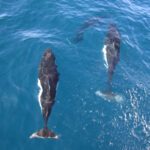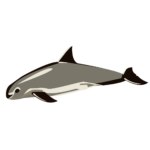The harbour porpoise, or Phocoena phocoena, is a small cetacean. Its body is streamlined, about 1.4 meters long, and up to 75 kilograms in weight. It has a unique dark gray or black top and lighter shade underneath.
Swimming at speeds of up to 55 km/hr, the porpoise is a skilled hunter. It feeds mainly on small fish like herring, cod, and sprat. Echolocation helps it locate its prey.
Harbour porpoises are not migratory. They stay close to shore or in estuaries. This may be because prey is more abundant there. They live in small groups, called pods, of up to five individuals. They cooperate and show strong bonds.
Observe these creatures from a distance – don’t disturb them!
Key Takeaways
- Harbour porpoises are small marine mammals that are found in coastal waters of the Northern Hemisphere.
- They are known for their distinctive triangular dorsal fin and dark grey or black coloration.
- Harbour porpoises are highly adapted for life in the water, with streamlined bodies and a layer of blubber for insulation.
- They primarily feed on small fish and squid, using echolocation to locate their prey.
- These porpoises are known for their shy and elusive nature, often avoiding boats and human interaction.
- Harbour porpoises are considered a species of least concern in terms of conservation status, but they still face threats from pollution, habitat degradation, and accidental entanglement in fishing gear.
- Efforts are being made to protect their habitats and reduce human impacts on their populations.
What is a Harbour Porpoise?

To better understand what a harbour porpoise is, dive into its physical description, habitat and distribution, and diet and feeding habits. Explore the distinct features and characteristics that define these marine creatures, discover where they can be found, and learn about their preferred food sources and eating behaviors.
Physical Description
The harbour porpoise is a truly remarkable creature. It measures around 4 to 6 feet, weighs between 110 and 130 pounds, and is dark gray on the back and lighter gray underneath. It also has a streamlined body and a rounded head, along with numerous sharp teeth. Its blowhole is positioned on top of its head, and it has a triangular dorsal fin in the middle of its back. These porpoises can swim at an impressive speed of up to 23 mph and dive deep into the depths for their prey.
Furthermore, harbour porpoises have incredible communication skills. They use clicks and whistles to guide their way. To truly appreciate this animal and its ecological importance, one must explore its habitat and distribution. Harbour porpoises are always on the move, like a mysterious slice of pizza! Don’t miss out on the chance to witness firsthand the wonders that lie beneath the waves.
Habitat and Distribution
Discovering the habitat and distribution of harbour porpoises is essential! Here are six points about their home:
- They live in the northern hemisphere’s coastal waters.
- From warm-temperate to subarctic waters, they roam far and wide.
- Fjords, bays and estuaries are their favourite habitats.
- These creatures hunt near continental shelves for prey.
- Their range is remarkable, stretching from Iceland to Japan.
- Occasionally, they even venture into freshwater rivers.
Let’s explore further! The coastline is an ideal spot for these porpoises. Adaptable to diverse water conditions, they swim in bountiful ecosystems. To witness such captivating creatures in their natural environment is a must-do! So, when given the chance, be sure to enjoy nature’s symphony and the beauty of harbour porpoises. Plus, they’ve mastered the art of seafood takeout with their fresh and fast fish deliveries!
Diet and Feeding Habits
Harbour porpoises have a diverse and fascinating diet. Their primary food consists of fish such as herring, cod and sand eels. They also eat cephalopods like squid and octopus.
These skilled hunters use echolocation to locate their prey underwater. They dive up to 200 meters to capture their prey.
The porpoises employ a method called “ram feeding” to maximize their chances of capturing food. This involves swimming through densely packed schools of fish with their mouths open.
If you want to observe the feeding habits of harbour porpoises, look for areas with abundant fish populations or join guided boat trips. You could even get lucky enough to spot a baby porpoise!
Life Cycle and Reproduction
The life cycle and reproduction of a harbour porpoise are amazing. Let’s explore the details and appreciate nature! Here’s a brief table:
| Stage | Length | Description |
|---|---|---|
| Gestation | 10-11 months | Female porpoises carry their young for nearly a year. |
| Birth | 1 calf | Usually, 1 calf is born, weighing 6 kilograms. |
| Growth | 2 years | The calf grows quickly, fed by its mother’s milk. |
| Independence | 2-3 years | By two to three years, the calf becomes independent. |
| Maturity | 3-7 years | Harbour porpoises become sexually mature between three and seven years. |
Besides these basics, they communicate with clicks, whistles, and trills. These vocalizations help social bonding and navigation.
In Alaska, a female porpoise was seen teaching her young how to hunt for food. She showed intelligent patience while guiding her inexperienced offspring. It was a beautiful display of instinctive nurturing.
The life cycle and reproduction of harbour porpoises offer wonders. From gestation to independence, these creatures charm us with their abilities and interactions.
Threats and Conservation Status: Pollution and fishing nets threaten harbour porpoises. They also face difficulty finding a date on PorpoiseHarmony.com.
Threats and Conservation Status
To understand the threats facing harbour porpoises and their conservation status, dive into the section “Threats and Conservation Status” that covers human activities and impact, as well as conservation efforts. Explore the strains imposed by human activities and discover the ongoing endeavors to safeguard these remarkable marine mammals.
Human Activities and Impact

Humans have a huge influence on the environment and its wellbeing. Our needs and wants can either maintain or endanger different species. For example, urbanization and infrastructure expansion lead to habitat destruction. Industrial activities also pollute air, water, and soil. Moreover, overusing natural resources for either recreation or commerce decreases biodiversity. Intensive agriculture with pesticides disturbs the ecological balance. Additionally, human-induced greenhouse gas emissions cause climate change, which is a major threat to habitats and species survival. Non-native species can also displace native ones and disrupt nature.
Furthermore, noise pollution from human activities interrupts wildlife communication patterns, affecting their reproduction and population dynamics. A clear example of human activity’s effect on nature is the near extinction of the American bison in the 19th century. Humans hunted these animals for their hides, reducing the population to a few hundred.
We must acknowledge our impacts on nature’s delicate equilibrium. Realizing this is essential for creating successful conservation strategies and protecting Earth’s biodiversity. Ironically, the biggest danger to endangered species is us—the species that claims to be their biggest supporters.
Conservation Efforts

For threatened species and their habitats, conservation efforts are in motion. These include:
- Making special areas where endangered species can exist undisturbed.
- Using sustainable practices to reduce human interference on wildlife and ecosystems.
- Letting local communities know about the importance of biodiversity conservation.
Also, governments, NGOs, and communities must work together for successful conservation efforts.
Other than this, conservation organizations explore to comprehend the requirements and behaviour of threatened species. This data helps create effective conservation strategies.
A fact: The World Wildlife Fund (WWF) has been really helpful in protecting endangered species worldwide. Harbour porpoises: they live like introverts, being peaceful and fascinating.
Interesting Facts about Harbour Porpoises
Harbour porpoises are small marine mammals. They have a slender body, meaning they can swim quickly and navigate their environment with ease. These creatures have a distinct look and some unique behaviors.
Did you know harbour porpoises are one of the smallest cetaceans? Adults measure 1.4 to 1.9 meters in length. But, don’t be fooled; these guys can dive deep – up to 200 meters – when they’re scavenging for food!
Harbour porpoises also use clicks and whistles to talk to each other and to echolocate. These sounds help them find food and get around.
Porpoises tend to live in small groups, called pods. The pods can be a few members or even up to twenty. Within these pods, they hunt together and look after each other’s young.
Harbour porpoises play a vital role in marine ecosystems. They help keep the food chain in balance. That’s why it’s so important to protect these animals and their habitats.
And, let’s not forget – harbour porpoises are genuinely adorable!
Frequently Asked Questions
What is a Harbour Porpoise?
A Harbour Porpoise is a small marine mammal found in coastal waters of the northern hemisphere. They are one of the smallest cetaceans and are known for their playful behavior and distinct appearance.
What do Harbour Porpoises look like?
Harbour Porpoises have a robust body, a small triangular fin, and a dark bluish-gray coloration on their backs. They have a distinctive small, rounded head with no beak and a dark ring around their eyes. Adult porpoises can reach lengths of up to 6 feet and weigh around 150 pounds.
Where do Harbour Porpoises live?
Harbour Porpoises are found in temperate and subarctic coastal waters of the northern hemisphere. They inhabit both the Atlantic and Pacific oceans, including regions such as the North Atlantic, North Pacific, and the Baltic Sea.
What do Harbour Porpoises eat?
Harbour Porpoises primarily feed on small fish species, such as herring, cod, and sand eels, as well as a variety of cephalopods. They use echolocation to locate and capture their prey.
Are Harbour Porpoises endangered?
While Harbour Porpoises are not listed as endangered globally, certain regional populations are considered at risk. Factors such as entanglement in fishing gear, habitat degradation, and pollution pose threats to their survival. Conservation efforts are focused on protecting their habitats and reducing human-induced threats.
Can Harbour Porpoises be kept in captivity?
Harbour Porpoises are not commonly kept in captivity due to their specific habitat and dietary requirements. The stress of captivity can have significant negative impacts on their health and well-being. Instead, efforts are made to observe them in the wild and promote their conservation.
Conclusion
Harbour porpoises are often mistaken for dolphins due to their size and shape. But they are a different family called Phocoenidae. They have a dark gray color on their upper side and lighter gray on their underside, helping them blend in with the water.
Unlike dolphins, which are known for their acrobatic displays, harbour porpoises swim in small groups called pods. Their diet mainly consists of small fish, like herring and cod. They use echolocation to find their prey underwater, then capture it with sharp teeth.
These porpoises are small, measuring only 4-5 feet long. They are listed as “Least Concern” by IUCN.
References




